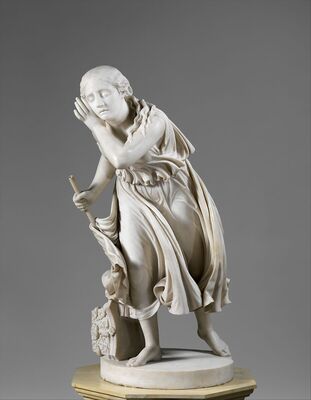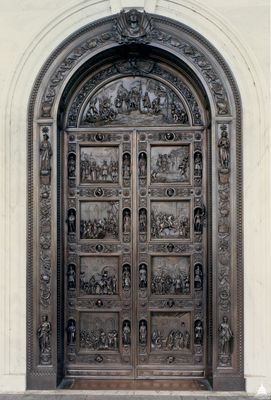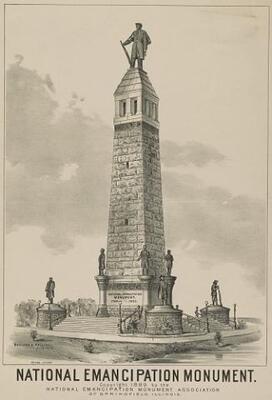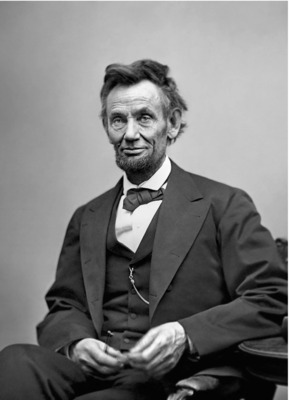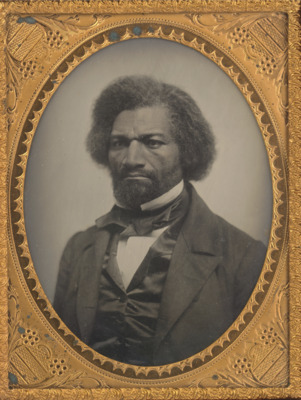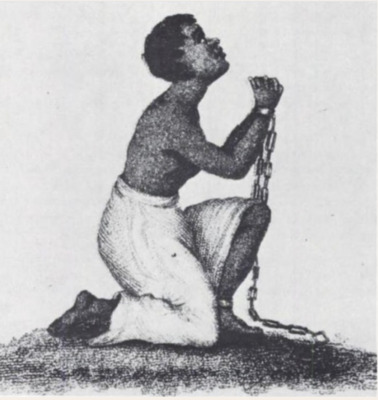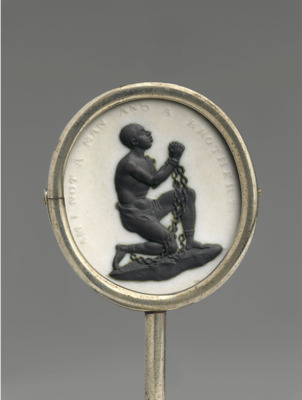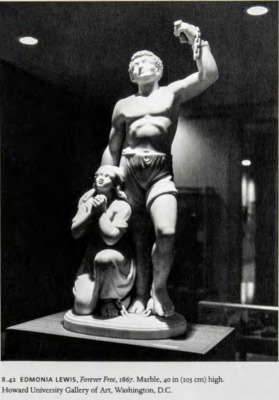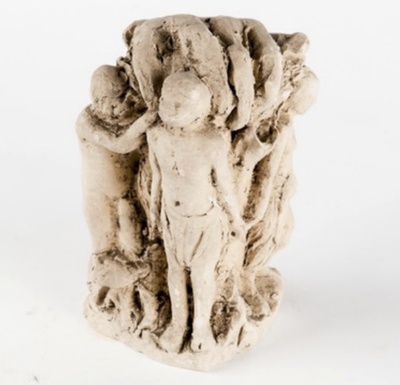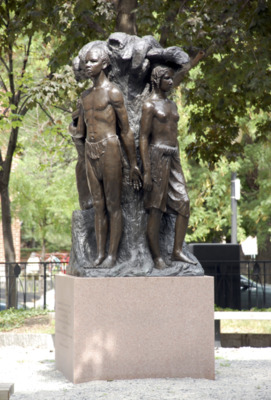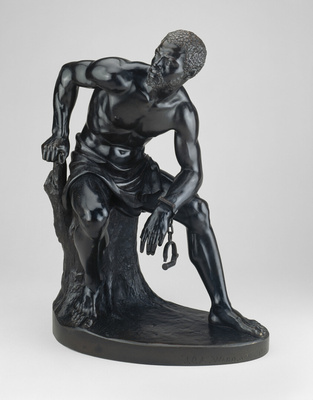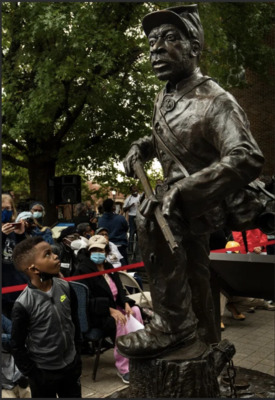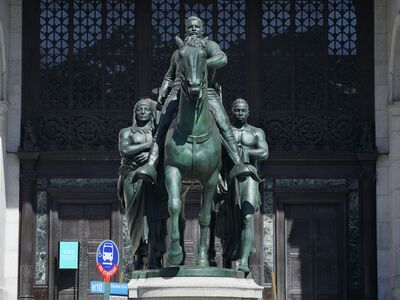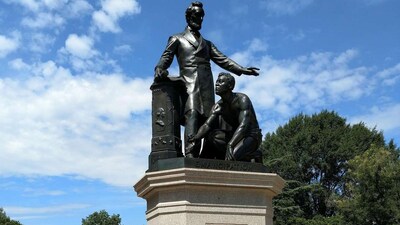Randolph Rogers' Lincoln and the Emancipated Slave - Contemporary and Historical Evaluations of Civil War Era Statues and Sculptures
Created By: Mackenzie Kempton, Bela Kellogg, Samantha Lipsit, Pranav Suresh, Caitlin Hagen
Introduction: Randolph John Rodgers was one of America’s premier monument makers during the nineteenth century, though contemporary sculptors such as Rogers, Thomas Crawford, and Hiram Powers have seldom been researched in the twenty-first century. Born in Waterloo, New York and raised in Ann Arbor, Michigan; Rogers taught himself how to draw and carve throughout the course of his adolescent employment. He started his career in magazine illustration, though he soon found a passion for carving and sculpture, and spent many late nights in New York with the Italian image makers who offered him supplies and advice. After moving to New York and being offered a position in a dry goods business, Rogers immediately impressed his employers with his sculptures. His employers invested in his talent, sending him from New York to Florence in 1848, where he studied with Lorenzo Bartolini. Bartolini, an Italian artist and “ardent revolutionary” was a peer of some of the most celebrated artists of the time, and “was considered the ‘restorer of the art of sculpture to its primitive, majestic, natural simplicity’” (Rogers 1971, 14). Through his studies in Italy, Rogers began producing idealized marble statuary, such as his Nydia, the Blind Girl of Pompeii which can be found here at UMMA. In Florence, Bartolini taught Rogers how to attract commissions, wherefore Rogers soon began shifting his creative focus from idealized marble statuary towards the public sphere. Some of his most popular commissions included his representation of nine scenes from the Life of Christopher Columbus on a pair of Bronze doors for an entrance to the Rotunda of the Capitol in Washington, DC (Headley 2003), and Lincoln and the Emancipated Slave.
Representational Struggles of Black Emancipators:
The commissioners of the World’s Columbian Exposition, imbued with a spirit of hate, and actuated by a caste of prejudice that has characterized their every ruling in the recognition of the colored race, [has] ruled us out, even though the crowning act of American valor and principle was Abraham Lincoln’s Emancipation Proclamation, and the bravery of the colored soldier and sailor who “attached victory from defeat” and saved the Union flag. (Freeman 1892, 2).
The resistance on the part of the World’s Columbian Exposition towards including this representation of black Americans represents how by the early 1890s, there was still hesitancy to associate black men with the greatness and progress of American civilization. Accordingly, this Springfield monument was ultimately never erected due to inadequate funding on the part of the National Emancipation Monument Association. As a result, Andre Cailloux, the man for whom the crowning statue represented, is a name that remains forgotten in the national consciousness. One can only wonder if this is in large part because in the absence of this 1890s monument, there are currently no other monuments immortalizing his legacy. The Concept of the “Emancipator” - Published Throughout Prominent African American Newspapers:
Emancipation is a topic that is highly discussed as there are ideas that go against one another when saying who the “Emancipators” were, one idea is the signer of the Emancipation Proclamation, Abraham Lincoln being the savior or “The Great Emancipator” for all enslaved people, versus the idea of the once enslaved persons and the people behind the abolition movement being the true emancipators.
Patrick Henry Reason (b.1816) was born in New York and attended New York's African Free School, he was one of the earliest African-American engravers and lithographers in the United States. He was active as an abolitionist and began his career by mentoring for a New York engraver. According to the book “Visualizing Equality: African American Rights and Visual Culture in the Nineteenth Century” Reason had advertised his business as an engraver of portraits of historical senses, portraits, and landscapes in a black newspaper called the “Colored American”. One of Reason’s most known commercial engravings was his production of the image named the “Kneeling Slave” in 1835. Reason created an image that resembled the Anti-slavery Medallion created in 1787 by Josiah Wedgwood.
The imagery of the “Kneeling Slave” was created to communicate to the British parliament in the late nineteenth century and early eighteenth century the need for abolition. The image was then used a little later in 19th-century America. As time has passed, however, this imagery is often critiqued with the idea that this motif of a Black figure kneeling connects blackness with subservience, as it shows the Black man waiting for others to set them free from their bondage.
According to an article published on the British Library website, the motif was “Popular in its day, in recent decades this image has been criticized for depicting enslaved Africans as passive and deferential while ignoring the resistance of enslaved and formerly enslaved people.Another one of Reason’s engravings resembling the “Kneeling Slave” motif is in the 1855 piece titled “A Colored Young Man of the City of New York” this version of the kneeling slave image was significant because it showed the enslaved man having a more innocent look on his face that is viewable to the onlooker rather than the man looking upwards to the heavens. It also had the line “Am I Not A Man And A Brother” above the man's head, which was an attempt to appeal to the emotions of viewers. Sculpture Produced by Edmonia Lewis Two years after the Emancipation Proclamation
Sculpture Produced by Meta Vaux Warrick Fuller
Meta Vaux Warrick Fuller (b. 1877) was born in Philadelphia. Later in her life, she studied at the Pennsylvania Museum and School of Industrial Art (now the University of the Arts) and moved to Paris to continue her studies in 1899. In 1913 she produced a piece entitled “Emancipation” the piece stayed as a plaster version and was later cast in bronze eighty years later. The piece was erected in Harriet Tubman Square in Boston Massachusetts and remained there to this day. According to the permanent exhibition section on the Danforth Museum of Art at Framingham State University website, “Fuller used the figure as a metaphor to represent broad themes as African-American artists and intelligentsia sought to formulate and celebrate an African-American cultural identity and express racial experience and social issues in America.”
Other Depictions of Emancipation:
With the Emancipation Proclamation in effect, questions of nationhood wavered. The nation was heading towards abolition, and there was ambivalence surrounding the thought of placing slave owners and formerly enslaved people under the same national flag. At this point, monuments displaying slavery in America could have either represented the black man as a self liberator, or as a plea for liberation from the white man. Just after Emancipation in 1863, John Quincy Adams Ward’s statuette titled Freedman was displayed in an exhibition in New York, and it encapsulated the former. For centuries, the neoclassicism of creating idealized fantasies, often of women in white marble, had been the tradition; Freedman offered a break against this status quo with Ward’s use of bronze to display the African American man. It was thought that this new order would “put the classical tradition in touch with the demands of contemporary reality” (Savage 2017, 55). The Freedman became the first representation of an African American in a bronze medium, though it was never erected for further purpose. After its reproduction, the sculpture had fallen inactive and thus ended the new idea of the African American body in sculpture. “Emancipation entered public sculpture instead through the body of the white hero Abraham Lincoln” (Savage 2017, 55).
Contemporary Re-Evaluations:
Despite the Civil War ending in 1865, the United States has a long and corrupt history of memorializing confederate imagery. Most Confederate monuments were erected in the period following Reconstruction and during Jim Crow. Confederate monuments were initially created to commemorate Confederate soldiers and supporters. The American people have since re-examined the meaning of these statues and public opinion of them has become majorly disapproved. The statues misrepresent history, and glorify those who allowed and participated in slavery, as well as an attempted secession from the United States. The statues remain a constant reminder of past and present institutionalized racism throughout America. After 73 Confederate monuments were removed or renamed in 2021, there are now 723 left in the US, according to the Southern Poverty Law Center. The 2020 Black Lives Matter movement spurred changes throughout the country including the public outrage for the removal of Confederate monuments. Many were defaced or torn down by protesters during marches and some were later scheduled for removal. In the report “Whose Heritage?”, along with the 723 monuments, there are 741 roadways, 201 schools, 51 buildings, and 38 parks that all reference and honor the confederacy and memorialize it. The top three individuals commemorated are Robert E. Lee, Jefferson Davis, and Stonewall Jackson. These unjust and hateful monuments symbolize the cruelties and inequality the United States once withheld. The complications of these removals is discussed by Michael Weinman, in the book, Learning from Charlottesville Before and After “Unite the Right”: Misrepresentation, Misrecognition, and Statue Politics, saying “that simply removing these memorials will not do much to help us recognize today the nature of the past misrecognition.”
While these monuments are undoubtedly symbols of hate, violence, and even serve as a rallying cries for far-right extremists, their impact remains widespread because of their locations: in public spaces all across the country. In the book, Critical Perspectives on Cultural Memory and Heritage: Construction, Transformation and Destruction, Vesyel discusses the impact these monuments have on public spaces throughout the United States, “While space is a social production which has been labored over by ordinary people, it is also significant for elites seeking to gain the power to control politics and economies.” Vesyel delves into the study of how cultural spaces and heritage affect the identities of those surrounding it. Monuments like those who commemorate Confederate leaders and ideals have negative effects on the communities as they represent symbols of hate and injustice. Similarly, a contemporary art group called Monument Lab works to cultivate and facilitate conversations about past, present, and future monuments.
Much of the focus of this debate has been on the exhibition of Confederate leaders and generals. As perceptions of historical figures have continued to change, so have attitudes towards historical statues. As art crime professor Erin Thompson at the City University of New York's John Jay College of Criminal Justice explained, "Statues have always been about power [...] From the beginning of human art-making, we see statues of rulers or powerful people, and they're meant to send messages" (Carrega & Allen, 2020).
A recent Quinnipiac University poll revealed that the percentage of individuals in favor of removing Confederate statues from public spaces in the United States has risen from 39% in 2017 to a majority of 52% in 2020 (Quinnipiac University Poll, 2020). As Americans grapple with the nation’s complicated history with race, many have stressed the impact that statues displayed in public space can have on historically marginalized people. Ben Wright, whose research at UT Austin focuses on the relocation of Confederate statues from public spaces to museum settings, explains this recent change in sentiment by writing “In light of the [White Nationalist] events of Charleston and Charlottesville, Confederate symbols can no longer be seen simply as benign anachronisms of a bygone era. Their power appears only to be dormant. They seem both dark and dynamic—endorsing, energizing and encouraging modern-day racism and authoritarianism” (Wright, 2019). Wright's statement highlights the fact that Confederate statues are not just harmless relics of the past, but instead continue to have an impact on contemporary attitudes towards race and power.
However, re-evaluations of historical statues are not limited to sculptures related to the Confederacy. In January of 2022, The American Museum of Natural History removed a controversial statue of former President Theodore Roosevelt. The statue depicted him on horseback flanked by a shirtless black and indigenous man on foot, communicating a racial hierarchy that the Museum and members of the public have long found disturbing (Treisman, 2022).[1] Criticism of the sculpture coincides with a growing examination of Roosevelt's complex views on race and eugenics. Similarly, Randolph Rogers’ Lincoln and the Emancipated Slave has been criticized for reinforcing racial hierarchies and for the depiction of the freed slave at Lincoln's feet, which has been interpreted by some as subservient.
The Freedmen’s Memorial to Abraham Lincoln in Washington, DC is a sculpture that is similar in intent and composition to Rogers' statue and has also received criticism. Renée Ater, Associate Professor of American Art in the Department of Art History and Archaeology at the University of Maryland has directed criticism towards the contrast in the way Lincoln and the emancipated subject are portrayed in the Freedmen’s Memorial. In her words, "I view it as a complete failure of representation, rooted in nineteenth-century Neoclassical image-making based in racial type (that can be traced back to ancient examples); condescending gesture in the guise of equality; and a celebration of mythic republican ideals that were never upheld [...] Its presence in 21st-century public space makes no sense." Ater specifically critiques the way the image is meant to be understood, explaining that "[the] difference between “the civilized man” and “the savage,” between Lincoln and the kneeling figure, is embedded in how we are meant to understand the image". This critique mirrors similar criticism the Roosevelt statue received regarding its presentation of race before its eventual removal.
As Americans continue to re-evaluate art displayed in public spaces, it is likely that more sculptures depicting previously revered heroes will be assessed critically. Negative depictions of Black Americans in sculpture preserves racist imagery and ideas in the American public consciousness. The gradual process of replacing these controversial statues with Black American heroes however demonstrates how Black Americans are reclaiming these spaces and not only transforming the narrative surrounding Black representation in art, but also challenging the way in which Americans remember and understand Black history in America.
--------------------------------
BIBLIOGRAPHY:
Apaydin, Veysel, ed. Critical Perspectives on Cultural Memory and Heritage: Construction, Transformation and Destruction. UCL Press, 2020. https://doi.org/10.2307/j.ctv13xpsfp.
This is a review on affects monuments have on public spaces and how they are correlated with the community around them.
Ater, Renee. “On the Removal of Statues: Freedmen's Memorial to Abraham Lincoln.” Renée Ater. Renée Ater, January 15, 2022. https://www.reneeater.com/on-monuments-blog/2020/7/1/on-the-removal-of-statues-freedmens-memorial-to-abraham-lincoln.
Blog by Professor Renee Atler discussing her criticism of the Freedmen’s Memorial to Abraham Lincoln in Washington D.C.
Carrega, Christina, and Karma Allen. “Historians Debate America's History of Racism and Confederate Monuments.” ABC News. ABC News Network, July 18, 2020. https://abcnews.go.com/US/historians-debate-americas-sordid-history-racism-confederate-monuments/story?id=71486827.
This article by Carrega and Allen for ABC News explores the movement to remove confederate statues in the summer of 2020 following the death of George Floyd. The article explores the opinions of academics and political figures on the issue.
Craven, Wayne. “Millard f. Rogers, Jr., Randolph Rogers, American Sculptor in Rome: Amherst, University of Massachusetts Press, 1971. Pp. 237; 88 Ills.; Biblio., Catalogue Raisonné. $ 17.50.” The Art Bulletin. Taylor & Francis, n.d. doi:10.1080/00043079.1973.10789730. https://www-tandfonline-com.proxy.lib.umich.edu/doi/abs/10.1080/00043079.1973.10789730
Wayne Craven reviews Millard F. Rogers biography book on Randolph Rogers and discusses some facts from Rogers’ childhood and career.
“Douglass on President Lincoln: Speakers Views on the Future of His Race; The Gathering at the Cooper institute”. New Orleans Tribune, June 18, 1865, p.1 Vol. 2- No. 250. Newsbank, accessed March 5th,2023 https://infoweb.newsbank.com/apps/readex/doc?p=EANX&t=year%3A1865%211865/product%3AEANAAA%21African%2BAmerican%2BNewspapers%252C%2BSeries%2B1&sort=YMD_date%3AA&fld-base-0=alltext&val-base-0=Lincoln%20AND%20MOSES&val-database-0=&fld-database-0=database&fld-nav-0=YMD_date&val-nav-0=&docref=image/v2%3A12B3C01E490E6BA0%40EANX-12BDFF5A48329260%402402406-12B8820E9B572928%400-12DA615705BBF4E0%40%255BIllegible%255D%2Bon%2BPresident%2BLincoln.%2B%255BIllegible%255D%2BGathering%2BAt%2BThe%2BCooper%2BInstitute.%2B%255BIllegible%255D%2BViews%2BOn%2BThe%2BFuture&firsthit=yes
This African American Newspaper article published by the New Orleans Tribune speaks about Abraham Lincoln’s assassination and Frederick Douglass delivering an oration. The journalist recalls Douglass commenting on how many African Americans there were mourning for the death of the man they connected with “Moses”. The journalist writes that Douglass says the death of the President had produced great “consternation” for the many Black Americans who were prospecting a bright future and that Douglass himself spoke of a bright future.
"Emancipation Monument. A Cut and Description of the One to Be Erected in Chicago." Plaindealer (Detroit, Michigan), August 21, 1891: 1. Readex: America's Historical Newspapers. https://infoweb.newsbank.com/apps/readex/doc?p=EANX&docref=image/v2%3A12B3BFC608F9BEA8%40EANX-12BC5DE26E893928%402411966-12BC1C07346D4F78%400-12E1AA0A5958E828%40Emancipation%2BMonument.%2BA%2BCut%2Band%2BDescription%2Bof%2Bthe%2BOne%2Bto%2BBe%2BErected%2Bin%2BChicago.
Describes the erection of a new emancipation monument to commemorate fallen black soldiers. Also describes the members of the National Emancipation Monument Association.
Finley, Cheryl. “VISUAL LEGACIES OF SLAVERY AND EMANCIPATION” Callaloo; Baltimore Vol. 37, Iss. 4, (Fall 2014): 1023-1032. ProQuest, accessed March 5th, 2023
https://proxy.lib.umich.edu/login?url=https://www.proquest.com/scholarly-journals/visual-legacies-slavery-emancipation/docview/1617334287/se-2.
This journal excerpt by Cheryl Finely is about the then-150th anniversary of the Emancipation Proclamation and allows the author to reflect on how artists have imagined or depicted slavery or the impact of slavery on people's lives. The journal also talks about the idea of symbolism when creating imagery revolving around emancipation or slavery and applying them to the idea of finding identity as a newly free person, and talks about how negative imagery or unflattering words would be associated with runaway enslaved peoples on circulated “run-away ads.” And the traditions of depicting slavery are brought up as well, and how that has shaped or been altered as time has gone on.
Freeman (Indianapolis, Indiana), January 11, 1890: 4. Readex: African American Newspapers. https://infoweb-newsbank-com.proxy.lib.umich.edu/apps/readex/doc?p=EANAAA&docref=image/v2%3A12B28495A8DAB1C8%40EANAAA-12BC6A74DC498808%402411379-12BC14F7033FF860%403.
Ghent, Henri. “Visual Creativity by Afro-Americans: a Critical Overview” Chicago Metro News, November 29, 1975, p. 3, 4, [7] , accessed March 5th, 2023 https://infoweb.newsbank.com/apps/readex/doc?p=EANX&t=product%3AEANAAA%21African%2BAmerican%2BNewspapers%252C%2BSeries%2B1&sort=YMD_date%3AA&page=1&fld-base-0=alltext&val-base-0=Sculpture%20of%20free%20slaves&val-database-0=&fld-database-0=database&fld-nav-0=YMD_date&val-nav-0=&docref=image/v2%3A12912DF42BF1884F%40EANX-12B5E0B79202E6A0%402442746-12B5E0B7E7B14528%406-12B5E0BA139F1240%40Visual%2BCreativity%2Bby%2BAfro-Americans%253A%2Ba%2BCritical%2BOverview&firsthit=yes
This article by Heri Ghent covers how art coming from African Americans cannot be looked at uniformly, when in reality Black artists come from the conditions or circumstances they grew up in. The writer points out that one should not think that African American artists will follow traditional African art because there is a severely severed ties between the motherland and forced “acculturation”, subsequently making it so that those art forms are no longer taught or known how to be done. He speaks of enslaved people pursuing art before the Civil War and how after the Civil War the number of Black people who went into the arts increased.
Gonzalez, Aston. “Visualizing Equality: African American Rights and Visual Culture in the Nineteenth Century.” Chapel Hill: The University of North Carolina Press, n.d. doi:10.5149/northcarolina/9781469659961.001.0001., accessed April 5th 2023
Gottbrath, Laurin-Whitney. “In 2020, the Black Lives Matter Movement Shook the World.” Racism | Al Jazeera. Al Jazeera, December 31, 2020. https://www.aljazeera.com/features/2020/12/31/2020-the-year-black-lives-matter-shook-the-world.
The Black Lives Matter Movement in 2020 is discussed here and its lasting effects on America as a whole.
Headley, Janet A. "Rogers, Randolph." Grove Art Online. 2003; Accessed 28 Mar. 2023. https://www-oxfordartonline-com.proxy.lib.umich.edu/groveart/view/10.1093/gao/9781884446054.001.0001/oao-9781884446054-e-7000072710.
This short biography on Randolph Rogers introduces Rogers and the onslaught of his art career.
Hineman, Brinley. “Statue Stands on Franklin Square Honoring Enslaved Troops Who Served in Civil War.” The Tennessean. Nashville Tennessean, October 23, 2021. https://www.tennessean.com/story/news/local/williamson/franklin/2021/10/23/franklin-tennessee-new-statue-enslaved-us-colored-troops/6033899001/.
The removal of a Confederate statue is discussed in Franklin Tennessee with the unveiling of a new monument that honors the US Colored Troops.
Howard-Woods, Christopher, Colin Laidley, and Maryam Omidi, eds. #Charlottesville: White Supremacy, Populism, and Resistance. OR Books, 2018. https://doi.org/10.2307/j.ctv62hg0j.
The effects of the Charlottesville protests are discussed here like the effects of removing the Robert E. Lee statue.
Kenworthy-Browne, John. “Lorenzo Bartolini: Plaster Models and Drawings. Palazzo Pretorio, Prato.” Burlington Magazine. The Burlington Magazine Publications, Ltd, n.d. https://www-jstor-org.proxy.lib.umich.edu/stable/879221?sid=primo
In this short biography, Kentworthy-Brown discusses Lorenzo Bartolini’s artistic career. He also examines the plaster models and drawings in an exhibition, two-hundred years after Bartolini’s honor.
Rogers, Millard F. Randolph Rogers: American Sculptor in Rome. University of Massachusetts Press, 1971.
Montalvo, R. Maria. Review of Remaking the Republic: Black Politics and the Creation of American Citizenship by Christopher James Bonner. Journal of the Civil War Era, Vol. 11, No. 2 (JUNE 2021), p. 278-280 (3 pages), jstor, accessed April 5th 2023 https://shibbolethsp.jstor.org/start?entityID=https%3A%2F%2Fshibboleth.umich.edu%2Fidp%2Fshibboleth&dest=https://www.jstor.org/stable/27088825&site=jstor
This review by Maria R Montalvo of the book “Remaking the Republic: Black Politics and the Creation of American Citizenship” by Christopher James Bonner talks about how the book centers around free Black Americans having to construct their own legal understandings as citizens, due to the language of the constitution being unspecific in relation to citizenship, identity, and the legality of it all. The book talks about the ideological and political activism done by Black Americans and dives into newspaper publications that are in regards to demonstrations or public organizers to get support for enslaved people to be freed from their bondage.
"National Emancipation Monument. The National Monument Association, at Springfield, Ill - the Temporary Monument, World's Columbian." Freeman (Indianapolis, Indiana), December 24, 1892: [2]. Readex: America's Historical Newspapers. https://infoweb.newsbank.com/apps/readex/doc?p=EANX&docref=image/v2%3A12B28495A8DAB1C8%40EANX-12CCE75E99208690%402412457-12CCE75EAAD462D0%401-12CCE75EE6C49750%40National%2BEmancipation%2BMonument.%2BThe%2BNational%2BMonument%2BAssociation%252C%2Bat%2BSpringfield%252C%2BIll%2B-%2Bthe%2BTemporary%2BMonument%252C%2BWorld%2527s%2BColumbian.
Details the controversy of how the World’s Columbian Fair Exposition thwarted the efforts of the National Emancipation Monument Association to display an emancipation monument to solicit funds from the public.
Oldfield, John “Abolition of the slave trade and slavery in Britain” British Library, 4 Feb 2021 https://www.bl.uk/restoration-18th-century-literature/articles/abolition-of-the-slave-trade-and-slavery-in-britain , accessed April 5th 2023
Rhoden, Giselle, and Dalila Paul. “73 Confederate Monuments Were Removed or Renamed Last Year, Report Finds.” CNN. Cable News Network, February 3, 2022. https://www.cnn.com/2022/02/02/us/confederate-monuments-removed-2021-whose-heritage/index.html.
This article discusses the different Confederate monuments that were removed or repalced in 2021.
"Robert E. Lee." The New York Age (New York, New York), May 31, 1890: 2. Readex: America's Historical Newspapers. https://infoweb.newsbank.com/apps/readex/doc?p=EANX&docref=image/v2%3A12B71576EF693118%40EANX-12CE2E36D9279B10%402411519-12CCE490AFA65570%401-12EA2A071135EA10%40Robert%2BE.%2BLee.
Details the perspective of black Americans regarding the erection of confederate monuments. This would be interesting to juxtapose against how black Americans view emancipation sculptures.
Savage, Kirk. “Standing Soldiers, Kneeling Slaves: Race, War, and Monument in Nineteenth-Century America.” Princeton: Princeton University Press, n.d. doi:10.1515/9781400889174. https://www-fulcrum-org.proxy.lib.umich.edu/epubs/rn3013846?locale=en#/6/22[Chapter03]!/4/12/1:281
In this book, Kirk Savage analyzes the implications of race, war, and monument in American nationhood in the post-civil war and abolition period.
“SPLC's 'Whose Heritage?' Report: A Teaching Opportunity.” Learning for Justice. Accessed April 18, 2023. https://www.learningforjustice.org/magazine/splcs-whose-heritage-report-a-teaching-opportunity.
This article discusses the current data of confederate monuments all across the US.
State Capital (Springfield, Illinois), June 6, 1891: 1. Readex: African American Newspapers. https://infoweb-newsbank-com.proxy.lib.umich.edu/apps/readex/doc?p=EANAAA&docref=image/v2%3A1314AC23DC10811F%40EANAAA-1318644D74AE4848%402411890-1318007663989068%400.
“The Freeman Panorama”. The Freeman, May 25th 1889, p. 4, Newsbank, accessed March 5th, 2023
https://infoweb.newsbank.com/apps/readex/doc?p=EANX&t=product%3AEANAAA%21African%2BAmerican%2BNewspapers%252C%2BSeries%2B1/pubname%3A12B28495A8DAB1C8%21Freeman&sort=YMD_date%3AA&fld-base-0=alltext&val-base-0=Frederick%20Douglass%20as%20Moses&val-database-0=&fld-database-0=database&fld-nav-0=YMD_date&val-nav-0=&docref=image/v2%3A12B28495A8DAB1C8%40EANX-12BC6A1E1FC5DD88%402411148-12BC14F654D16FF0%403-12DB0C9D 29550E0%40The%2BFreeman%2BPanorama&firsthit=yes
This publication from the African American newspaper The Freeman is a criticism of sorts in regards to Frederick Douglass, nonetheless sings the prayers of how he has earned the title “Moses” and has become the “sage and philosopher.” The critique is that Douglass is too good for trying to gain a political office job and that in fact, the office should seek him instead. The article also mentions some heavy statements about how the white man should not be afraid of Black people as they already have everything in the palm of their hand or control, more so than they did for four years when the confederates went off to war to preserve the institution of slavery.
Treisman, Rachel. “New York City's Natural History Museum Has Removed a Theodore Roosevelt Statue.” NPR. NPR, January 20, 2022. https://www.npr.org/2022/01/20/1074394869/roosevelt-statue-removed-natural-history-museum.
This article by Treisman for NPR explains why the Natural History Museum in New York City removed a controversial statue of former President Theodore Roosevelt and ties it to the greater national debate on the role of statues depicting historical figures in public spaces.
Wright, Ben. 2019. “Confederate Statues and Their Dirty Laundry.” Journal of the Gilded Age & Progressive Era 18 (3): 349–59. doi:10.1017/S1537781419000070.
Researcher Ben Wright at UT Austin writes about the removal of confederate statues on UT Austin campus following white nationalist rallies in Charleston & Charlottesville as well as their origin.
“68% Say Discrimination against Black Americans a ‘Serious Problem," Quinnipiac University National Poll Finds; Slight Majority Support Removing Confederate Statues: Quinnipiac University Poll.” 6/17/20 - 68% Say Discrimination Against Black Americans A "Serious Problem," Quinnipiac University National Poll Finds; Slight Majority Support Removing Confederate Statues | Quinnipiac University Poll. Accessed April 18, 2023. https://poll.qu.edu/Poll-Release?releaseid=3786.
This poll conducted by Quinnipiac University in the summer of 2020 quantifies how public opinion has shifted on the issue of confederate statues in public spaces.
PHOTO CITATIONS:
Ater, Renée. Remaking Race and History: The Sculpture of Meta Warrick Fuller. Berkeley: University of California Press, 2011, accessed March 20th, 2023 <https://www.slaverymonuments.org/items/show/1121>
Caden Gentry 6, Looks up at the at the Historic USCT Soldier Statue during the Unveiling and Dedication Ceremony at the City Square Saturday, Oct. 23, 2021 in Franklin, Tenn. n.d. The Tennessean. https://www.tennessean.com/story/news/local/williamson/franklin/2021/10/23/franklin-tennessee-new-statue-enslaved-us-colored-troops/6033899001/.
Clary, Timothy A. The Theodore Roosevelt Equestrian Statue Is Shown in Front of the American Museum of Natural History's Central Park West Entrance in New York City in 2020. n.d. https://www.npr.org/2022/01/20/1074394869/roosevelt-statue-removed-natural-history-museum.
The Columbus Doors. n.d. https://www.aoc.gov/explore-capitol-campus/art/columbus-doors.
Danforth Art Museum, Maquette for Spirit of Emancipation by Meta Vaux Warrick Fuller (1877–1968), 1913, accessed March 30th, 2023 <https://danforth.framingham.edu/wp-content/uploads/2021/05/Juneteenth-Lesson.pdf >
Emmancipation Memorial. n.d. National Park Service. https://www.nps.gov/places/000/emancipation-memorial.htm.
The Freedman. n.d. https://www.artic.edu/artworks/149776/the-freedman.
Gardener, Alexander 1865, from The New Yorker, accessed April 10, 2023 <https://www.newyorker.com/magazine/2020/09/28/why-we-keep-reinventing-abraham-lincoln>
The Met Museum, Anti Slavery Medallion, accessed March 6th, 2023 <https://www.metmuseum.org/art/collection/search/19107>
Nydia, the Blind Flower Girl of Pompeii. n.d. https://www.metmuseum.org/art/collection/search/11951.
Patrick Henry Reason, [Supplicant Slave], frontispiece from Lydia Maria Child, The Fountain for Every Day in the Year, 1836. Courtesy of the American Antiquarian Society, accessed March 6th, 2023 <https://web.p.ebscohost.com/ehost/ebookviewer/ebook/ZTAwMHhuYV9fMjQzMjY2MF9fQU41?sid=5fd98e8b-2a9e-43f1-b6d0-64317c9e4cf4@redis&vid=0&format=EB&rid=1>
Picture of Confederate Soldier That Residents of Franklin, Tennessee Are Petitioning to Remove. n.d. Change.Org. https://www.change.org/p/mayor-ken-moore-remove-the-confederate-monument-in-franklin-tn.
Portrait of Lorenzo Bartolini. n.d. https://commons.wikimedia.org/wiki/File:Mus%C3%A9e_Ingres-Bourdelle_-_Portrait_de_Lorenzo_Bartolini;_1805_-_Ingres_-_Joconde06070000015.jpg.
The Statue That Never Was. n.d. https://naucenter.as.virginia.edu/statue-never-was.
Unidentified Artist, 1856 , Photograph, from the National Portrait Gallery, accessed April 10, 2023 <https://npg.si.edu/object/npg_NPG.74.75>
Wooliver,Shannon, Reason, A Colored Young Man in the City of New York, 1855, engraving: Poverty in American Black Art, accessed March 6th, 2023 <https://lplsalon.wordpress.com/patrick-reason-a-colored-young-man-in-the-city-of-new-york/>
Created For
K-12 EducatorK-12 Student
Museum Visitor
UMMA Docent
UMMA Staff
University Faculty
University Student
Rate this Resource
AVG: 0 | Ratings: 0
& Author Notes
Creative Commons by-nc-saLast Updated
April 19, 2023 9:07 p.m.Report
Reporting Policy

